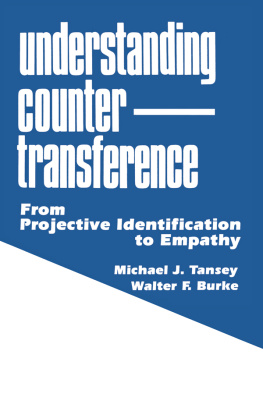Gabbard Glen O. - Management of countertransference with borderline patients
Here you can read online Gabbard Glen O. - Management of countertransference with borderline patients full text of the book (entire story) in english for free. Download pdf and epub, get meaning, cover and reviews about this ebook. City: Northvale, N.J., year: 2000, publisher: Jason Aronson, genre: Romance novel. Description of the work, (preface) as well as reviews are available. Best literature library LitArk.com created for fans of good reading and offers a wide selection of genres:
Romance novel
Science fiction
Adventure
Detective
Science
History
Home and family
Prose
Art
Politics
Computer
Non-fiction
Religion
Business
Children
Humor
Choose a favorite category and find really read worthwhile books. Enjoy immersion in the world of imagination, feel the emotions of the characters or learn something new for yourself, make an fascinating discovery.

- Book:Management of countertransference with borderline patients
- Author:
- Publisher:Jason Aronson
- Genre:
- Year:2000
- City:Northvale, N.J.
- Rating:5 / 5
- Favourites:Add to favourites
- Your mark:
- 100
- 1
- 2
- 3
- 4
- 5
Management of countertransference with borderline patients: summary, description and annotation
We offer to read an annotation, description, summary or preface (depends on what the author of the book "Management of countertransference with borderline patients" wrote himself). If you haven't found the necessary information about the book — write in the comments, we will try to find it.
Management of countertransference with borderline patients — read online for free the complete book (whole text) full work
Below is the text of the book, divided by pages. System saving the place of the last page read, allows you to conveniently read the book "Management of countertransference with borderline patients" online for free, without having to search again every time where you left off. Put a bookmark, and you can go to the page where you finished reading at any time.
Font size:
Interval:
Bookmark:
Management of
Countertransference
with Borderline Patients
Countertransference
with Borderline Patients
GLEN O. GABBARD, M.D.
and
SALLYE M. WILKINSON, Ph.D.

A JASON ARONSON BOOK
ROWMAN & LITTLEFIELD PUBLISHERS, INC.
Published in the United States of America
by Rowman & Littlefield Publishers, Inc.
A wholly owned subsidiary of The Rowman & Littlefield Publishing Group, Inc.
4501 Forbes Boulevard, Suite 200, Lanham, Maryland 20706
www.rowmanlittlefield.com
Estover Road
Plymouth PL6 7PY
United Kingdom
Note: The authors have worked to ensure that all information in this book concerning drug dosages, schedules, and routes of administration is accurate as of the time of publication and consistent with standards set by the U.S. Food and Drug Administration and the general medical community. As medical research and practice advance, however, therapeutic standards may change. For this reason and because human and mechanical errors sometimes occur, we recommend that readers follow the advice of a physician who is directly involved in their care or the care of a member of their family.
First softcover edition, 2000
Copyright 1994 by American Psychiatric Press, Inc.
Reprinted by arrangement with American Psychiatric Press.
All rights reserved. No part of this book may be used or reproduced in any manner whatsoever without written permission from Jason Aronson Inc. except in the case of brief quotations in reviews for inclusion in a magazine, newspaper, or broadcast.
Library of Congress Cataloging-in-Publication Data
Gabbard, Glen O.
Management of countertransference with borderline patients / Glen O. Gabbard, Sallye M. Wilkinson.
p. cm.
Originally published: Washington, D.C.: American Psychiatric Press, 1994.
Includes bibliographical references and index.
ISBN 0-7657-0263-0 ISBN: 978-0-7657-0263-0
1. Borderline personality disorderTreatment. 2. Countertransference (Psychology) I. Wilkinson, Sallye M. II. Title.
RC569.5.B67 G33 2000
616.85'8520651dc 21
00056913
Printed in the United States of America on acid-free paper. For information and catalog write to Jason Aronson Inc., 230 Livingston Street, Northvale, New Jersey 07647-1726. Or visit our website: www.aronson.com
The authors gratefully acknowledge permission to reprint portions of the following material:
Gabbard GO: Splitting in Hospital Treatment. American Journal of Psychiatry 146:444451, 1989. Copyright 1989, the American Psychiatric Association. Portions reprinted with permission in Chapter 8.
Gabbard GO: Technical Approaches to Transference Hate in the Analysis of Borderline Patients. International Journal of Psychoanalysis 72(4):625637, 1991. Copyright Institute of Psycho-Analysis, London, 1991. Portions reprinted with permission in Chapter 5.
Gabbard GO: The Therapeutic Relationship in Psychiatric Hospital Treatment. Bulletin of the Menninger Clinic 56(1):419, 1992. Copyright 1992, the Menninger Foundation. Portions reprinted with permission in Chapter 8.
Gabbard GO: An Overview of Countertransference With Borderline Patients. Journal of Psychotherapy Practice and Research 2(1):718, 1993. Copyright 1993, American Psychiatric Press, Inc. Portions reprinted with permission in Chapter 1.
Wilkinson SM, Gabbard GO: Therapeutic Self-Disclosure With Borderline Patients. The Journal of Psychotherapy Practice and Research 2:282295, 1993. Copyright 1993, American Psychiatric Press, Inc. An expanded version of this article appears with permission as Chapter 7.
Few disorders in psychiatry would warrant an entire volume devoted to the emotional reactions they generate in the clinicians who treat them. Borderline personality disorder is unique in its capacity to stir up affects that overwhelm treaters. In the best of circumstances, the feelings activated in the treatment of such patients provide crucial data about the patients internal world that may help to resolve a treatment impasse. In the worst of circumstances, the countertransference evoked in the treatment may compel clinicians to pursue ill-advised courses of action that result in unethical boundary transgressions by the therapist or suicide attempts by the patient.
In the course of conducting seminars throughout the country on the treatment of borderline patients, we have been struck by the ravages of countertransference in mental health professionals who treat borderline patients. The personal and professional lives of those clinicians are affected in an extraordinary way. Some clinicians describe being driven crazy by such patients. Others feel their personal lives have been so invaded that they must tell their children not to answer the telephone when it rings. Still others have vowed never to treat another borderline patient because they simply cant take it anymore.
The book we have written is designed to address the emotional tempest that therapists who treat borderline patients must face. We have provided a systematic approach to examining and managing the myriad countertransference reactions that arise in the course of treatment. We have chosen to illustrate this approach by reporting detailed accounts of the minute-by-minute and hour-by-hour interaction between therapist and patient. Although the management of countertransference is only one aspect of the overall treatment of persons with borderline personality disorder, it is clear that no other part of the treatment can be carried out in the manner intended if the clinicians emotional reactions are not taken into account first.
Treatment of borderline patients has a long and distinguished tradition at The Menninger Clinic. Indeed, the very notion of the borderline patient originated in the seminal writings of Robert Knight when he worked at The Menninger Clinic in the 1950s. During the 1960s and early 1970s, while Otto Kernberg was director of the C. F. Menninger Memorial Hospital, his classic papers on the concept of borderline personality organization were published. In the last two decades, borderline patients have been referred to The Menninger Clinic from all over the world, and groups of clinicians and researchers have continued to devote much of their careers to the understanding and treatment of these difficult-to-treat patients.
Our collaboration as coauthors of this volume began as a supervisor-supervisee relationship. As the two of us mutually struggled to articulate a methodology with which to approach the overwhelming emotional reactions encountered in the psychotherapy of borderline patients, the mentor-mentee nature of the relationship evolved over a period of a few years into a collegial collaboration. We first presented material at the 1991 annual meeting of the American Psychiatric Association in New Orleans in the Continuous Clinical Case Seminar format. The overflow crowd and the enthusiasm of the audience in attendance convinced us that our work should be expanded to monograph form. We have designed the book to be useful to both experienced and beginning therapists of all professional disciplines.
Writing about countertransference requires an uncompromising honesty. Although we have disguised clinical material so that patients are not recognizable, we have tried to be as open as possible about our own feelings that we encountered in the course of our work. We are grateful to a number of our Menninger colleagues who graciously shared some of their feelings in specific cases that we discussed with them. Many of their struggles also appear on the pages of this volume. The difficult self-revelation required by these accounts will be well worth it if other clinicians find them enriching and useful in their own work.
Next pageFont size:
Interval:
Bookmark:
Similar books «Management of countertransference with borderline patients»
Look at similar books to Management of countertransference with borderline patients. We have selected literature similar in name and meaning in the hope of providing readers with more options to find new, interesting, not yet read works.
Discussion, reviews of the book Management of countertransference with borderline patients and just readers' own opinions. Leave your comments, write what you think about the work, its meaning or the main characters. Specify what exactly you liked and what you didn't like, and why you think so.








